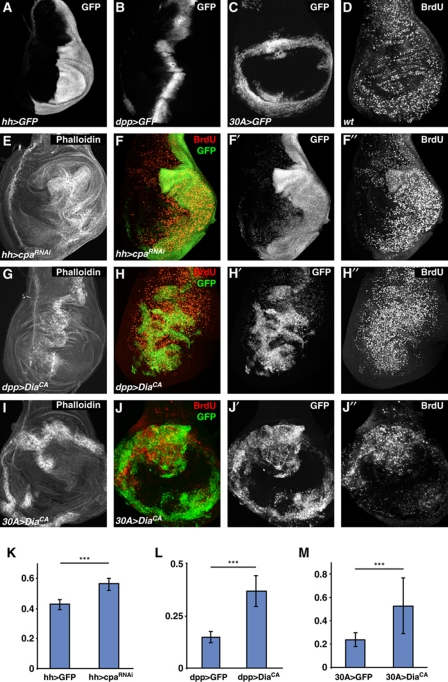Figure 2.
Induction of F-actin polymerization induces overgrowth of imaginal discs. (A–J) Confocal images of third instar wing imaginal discs showing (A) UAS-GFP expression driven by hh-Gal4, (B) UAS-GFP expression driven by dpp-Gal4, and (C) UAS-GFP expression driven by 30A-Gal4. (D) BrdU incorporation in a wild-type disc. (E) Phalloidin staining of hh-Gal4, UAS-GFP, UAS-cpaRNAi. (F) BrdU (red, grey in F′′) and GFP (green, grey in F′) staining of hh-Gal4, UAS-GFP, UAS-cpaRNAi. (G) Phalloidin staining of dpp-Gal4, UAS-GFP, UAS-diaCA. (H) BrdU (red, grey in H′′) and GFP (green, grey in H′) staining of dpp-Gal4, UAS-GFP, UAS-diaCA. (I) Phalloidin staining of 30A-Gal4, UAS-GFP, UAS-diaCA. (J) BrdU (red, grey in J′′) and GFP (green, grey in J′) staining of 30A-Gal4, UAS-GFP, UAS-diaCA. (K–M) Quantification of the size of the GFP expression domains normalized to the size of the entire imaginal disc of the indicated genotypes. *** indicates that the two populations are different with P<0.001. Note that Gal4 in the dpp- and 30A-Gal4 driver lines is not stably expressed in cell lineages but is lost when progenitor cells move away from the domain where Gal4 expression was induced. Therefore, non-GFP expressing cells may show upregulated BrdU due to earlier Gal4 expression driving DiaCA. Thus, seemingly non-autonomous effects may still be due to cell autonomous action of DiaCA. Similar effects may apply to analysis of the expression of ex-lacZ in Figure 3.

